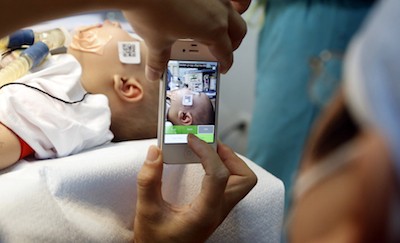Using a Smartphone to Diagnose Cancer
| Michael A. Katz | | Apr 14, 2015 02:26 PM EDT |
(Photo : Reuters) A team of scientists have developed a method for detecting cervical cancer using smartphone technology.
Many people overdramatically claim that they can't live without their smartphone, but a team of scientists in Boston may have made that a reality by creating a method of diagnosing cancer using smartphone technology.
According to new research published in the scientific journal Proceedings of the National Academy of Sciences, the scientists created an approach to enable molecular diagnostics on smartphones.
Like Us on Facebook
"Smartphones and wearable electronics have advanced tremendously over the last several years but fall short of allowing their use for molecular diagnostics," said the report.
The approach uses molecular-specific microbeads to create unique diffraction patterns of so-called "blurry beads." These "blurry beads" can then be recorded and deconvoluted through digital processing.
"We applied the system to resolve individual precancerous and cancerous cells as well as to detect cancer-associated DNA targets," said the report. "Because the system is compact, easy to operate, and readily integrated with the standard, portable smartphone, this approach could enable medical diagnostics in geographically and/or socioeconomically limited settings with pathology bottlenecks."
According to research group eMarketer, the number of smartphone users worldwide will surpass 2 billion in 2016, and their near ubiquity make them the model tool for cancer diagnosis, particularly in remote regions of the world.
The integrated sensors and communication capabilities of smartphones "makes them an ideal platform for point-of-care (POC) diagnosis, especially in resource-limited settings," said the report. "Molecular diagnostics, however, have been difficult to implement in smartphones."
Because of this difficulty, the scientists have used a diffraction-based approach that allows for the use of molecular and cellular diagnostics. The digital diffraction diagnosis (D3) system uses microbeads to generate unique diffraction patterns which can be acquired by smartphones and processed by a remote server.
"We applied the D3 platform to screen for precancerous or cancerous cells in cervical specimens and to detect human papillomavirus (HPV) DNA," said the report. "The D3 assay generated readouts within 45 min and showed excellent agreement with gold-standard pathology or HPV testing, respectively."
The report added that the approach "could have favorable global health applications where medical access is limited."
On of the team's leaders, Ralph Weissleder, of Massachusetts General Hospital, Boston, is planning on using an HIV project in Botswana to test the device's ability to detect cancer, according to New Scientist magazine.
There are fewer than 10 pathologists in the whole of Botswana, team member Cesar Castro, also of Massachusetts General Hospital, told New Scientist.
"They don't have many chemotherapies available so there's an opportunity to make a real difference ," said Castro. "We can use our technology as a kind of triage system, to flag up samples that look suspicious and help put resources to the best use."
TagsUsing a Smartphone to Diagnose Cancer, Massachusetts General Hospital, Boston, blurry beads, molecular-specific microbeads
©2015 Chinatopix All rights reserved. Do not reproduce without permission
EDITOR'S PICKS
-

Did the Trump administration just announce plans for a trade war with ‘hostile’ China and Russia?
-

US Senate passes Taiwan travel bill slammed by China
-

As Yan Sihong’s family grieves, here are other Chinese students who went missing abroad. Some have never been found
-

Beijing blasts Western critics who ‘smear China’ with the term sharp power
-

China Envoy Seeks to Defuse Tensions With U.S. as a Trade War Brews
-

Singapore's Deputy PM Provides Bitcoin Vote of Confidence Amid China's Blanket Bans
-

China warns investors over risks in overseas virtual currency trading
-

Chinese government most trustworthy: survey
-

Kashima Antlers On Course For Back-To-Back Titles
MOST POPULAR
LATEST NEWS
Zhou Yongkang: China's Former Security Chief Sentenced to Life in Prison

China's former Chief of the Ministry of Public Security, Zhou Yongkang, has been given a life sentence after he was found guilty of abusing his office, bribery and deliberately ... Full Article
TRENDING STORY

China Pork Prices Expected to Stabilize As The Supplies Recover

Elephone P9000 Smartphone is now on Sale on Amazon India

There's a Big Chance Cliffhangers Won't Still Be Resolved When Grey's Anatomy Season 13 Returns

Supreme Court Ruled on Samsung vs Apple Dispute for Patent Infringement

Microsoft Surface Pro 5 Rumors and Release Date: What is the Latest?













